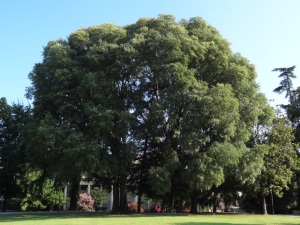My trees, they are hackberries, or nettle trees. Celtis australis is their Latin name. I have a hard drive full of portraits of these trees, nearly all of them shot from the same spot near a lamppost in the park, and each is different. The project has been a good exercise, and I’m not done yet.
I started in early 2012 after reading a slim book on photography and meditation, aptly titled Meditazione e Fotografia. It suggested exercises for using your camera as another eye, and so photography as a means of seeing more clearly the world around you. This appealed to me. In one of the exercises, you were to photograph the same subject, a simple object, over and over and over again, exploring it completely. The example given was of a rock, and I had a rock, but I was intent on putting that rock behind me. The rock would not do.
Another exercise was to take a picture of the sky every single day, which would train you to notice its infinite differences from one day to the next, but the sky was too abstract and distant. I needed something I could hold on to, something in the natural world that I could see and smell and touch. Something that inspired wonder, like the sky, and that was tangible, like a rock, but that was alive, like me. I needed a living, changing thing. One that would not die before the end of the year, or whenever I was satisfied that the project was complete. It had to be a tree.
I had been thinking a lot about trees since Hurricane Irene in August 2011, when our flight from Maryland to Italy was cancelled, affording me an extra week of respite before I had to face my life again. The night of the storm the winds were so strong that the long, slender trunks of the trees behind my parents’ house curved over sideways, the branches trembling and leaves slick and shiny but mostly hanging on. In the morning, those trees stood upright in the sun. Except for some branches on the ground, it was as if nothing had happened. They were probably all the stronger for it. Now that was a fine example of resilience if I had ever seen one.
In January, I looked around for a subject and chose these. I remembered how classy they were in the spring and summer when no longer bare, and I liked the way their trunks looked like columns and the start of their roots like feet. I liked knowing I’d have an excuse to go to the park every single day. I just knew it had to be these trees without knowing precisely why. And so, every day, or almost every day, I went to take my picture of the trees. I always looked forward to it, especially in the winter, when it often brought a sense of purpose to my day, and especially on cold, dark days when I was alone without the boys.
Then, spring came and the tips of my trees began to turn green. It was nothing less than thrilling, and it happened so fast! In a matter of days, they were covered in leaves.
More than half a year went by before I decided I had to know what kind of tree they were. Until then it hadn’t mattered, but suddenly it was imperative. It took me some time to figure it out, and when I did, with the help of a friend, I clearly saw how perfect my choice had been.
In Italian, the celtis australis has a handful of names: bagolaro, romiglia, lodogno and my favorite, the spaccassassi, which means a tree whose roots are so strong they break the rocks in the soil. Ha!
The wood of the nettle tree is light, hard, flexible, tough, elastic and long-lasting. Its strong root system enables it to survive and thrive in karstic and rocky terrain.
Yes. That is exactly the kind of tree for me. That is the tree that I would be.





Love this idea, what a lovely trees.
Good job Jennifer! I liked also background plazzo ! Saluti da puglia!
You are that tree!